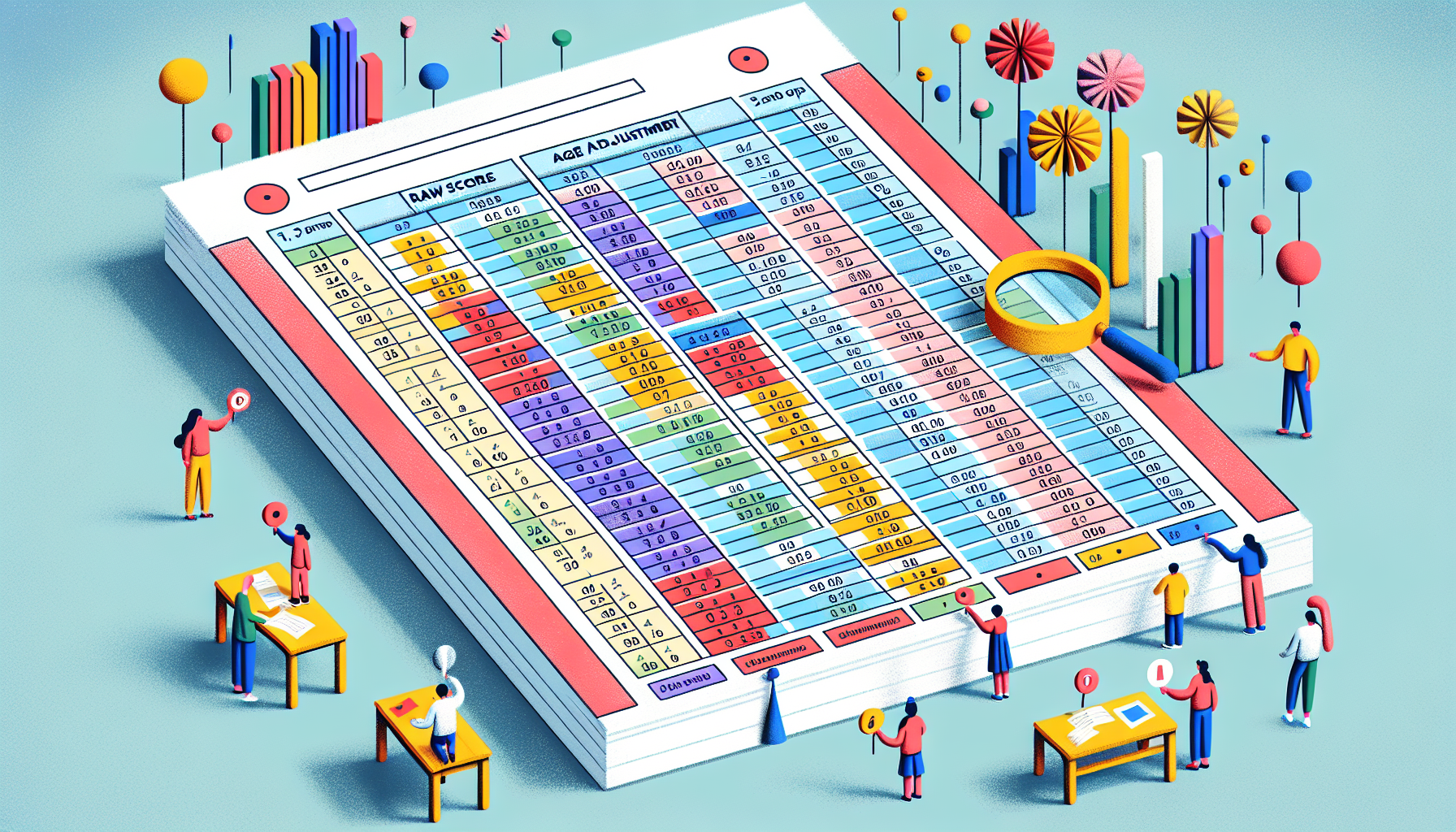The 11 Plus Standardised Scores Calculator and Table: A Comprehensive Guide
Wondering how to navigate the 11 Plus standardised scores table? This concise guide will clarify how standardised scoring works, why it’s used, and how to interpret these crucial figures. Whether you’re a parent or educator, understanding these scores is vital for assessing student readiness for secondary education. Expect to learn about raw score conversion, the importance of age adjustments, and the implications of these scores for school placement.
Key Takeaways
- Standardised scores in the 11 Plus exam are adjusted for factors like age and paper difficulty to ensure fairness among students of varying ages and across different test papers, with additional marks given to younger students to offset age-related advantages.
- The 11 Plus Standardised Scores Table helps convert raw scores to standardised scores, providing a range typically from 50 to 150, where a score of 100 is considered average and used to determine eligibility for grammar school placement.
- Preparation for the 11 Plus exam is essential and can be approached through practice papers, study materials, tutoring, and adhering to a structured revision schedule beginning at least six months before the exam.
Understanding 11 Plus Standardised Scores
The 11 Plus exam is a crucial turning point that can determine the academic trajectory of a child. One significant factor to take into consideration is their standardised score, which refers to an adjusted score accounting for age and test paper difficulty to ensure fair comparison among students. This process allows for equal evaluation of all candidates, including younger children who may be at a disadvantage due to their age.
To calculate the final standardized score, raw scores from different papers are modified and combined. The aim is also to give each test paper equal weight in determining the overall result despite varying levels of difficulty. To establish this minimum standardised score required for passing, average scores and number of applicants are taken into account.
Understanding how stanine placement works are equally important as it positions students’ individualized standardized scores on a scale ranging from one (lowest)to nine (highest), with five being considered average within their respective age group. This method ensures equitable comparisons between student performances even when comparing older versus younger individuals whose standardized scores may differ solely based on age or other external factors.
Purpose of standardisation
The main objective of standardisation in 11 Plus exams is to ensure fairness among all participants. This is done by adjusting raw scores so that every student receives a minimum standardised score. Standardised scores are used for comparison with a nationally representative group of students from the same age group, providing an objective measure of performance and allowing for meaningful comparisons between individuals and groups.
In 11 Plus exams, standardisation guarantees several things: each test carries equal weight regardless of its length or time limit, marks from different papers within the exam are combined to determine an average raw score, and there is consistency across various tests in terms of scoring methods. These factors play a crucial role during the process of age standardisation, which aims to achieve similar standards among students taking different versions or variations of the exam. Overall, it ensures that everyone’s efforts are fairly assessed based on their performances as reflected by their resulting scores.
Benefits of standardisation
Standardisation guarantees an equal contribution of each test paper to the total score calculation, eliminating discrepancies due to differences in test length or question quantity. This equal weighting preserves the principle of fairness. It addresses variable elements in test scoring, such as the number of questions and time constraints, allowing for an equitable comparison of student performance across various test papers and age groups.
Age adjustments are another significant benefit of standardisation. They serve to equalize opportunities for younger students who might face a disadvantage due to their age. This ensures equitable assessment for all children, resulting in age standardised scores that are fair for all students.
The 11 Plus Standardised Scores Table

The 11 Plus Standardised Scores Table is a tool that displays the comparison between an individual’s raw score and all other scores on the test. It represents an average standardised score of 100, with a range from approximately 50 to 150. It should be noted that scores above 130 or below 70 are uncommon.
Calculating a student’s SAS involves several steps.
- First, determine their attainment estimate by considering their number of correct and incorrect answers across various test papers.
- Next, take into account the child’s age in years and months at the time they took the exam.
- Finally, convert these numbers into a standardised age score (SAS) which shows how well they performed compared to others in the same age group.
To transform a raw score into its corresponding standardised equivalent usingthe11PlusScoresTable, you need to identify what approximate raw score would result in a minimum standardising score. You can find this information within the table itself using the different tests given equal weight for calculation purposes. Therefore, this process takes into consideration the number of questions, the child’s age, and the scores required for a minimum standardized performance level. Finally, this results in a calculated StandardAge Score(SAS).
Components of the table
The 11 Plus Standardised Scores Table uses raw scores to directly calculate a student’s standardised score. The table includes the range of lowest (around 69 or 70) and highest scores (usually around 140 or 141), as well as an eligibility threshold.
The table also shows standard deviations, with a mean of 100 and a deviation of 15 being common reference points for evaluating student performance based on their scores.
Using the table
The 11 Plus Standardised Scores Table is used to transform raw scores into standardised scores, enabling a fair comparison among all students taking the test. It mitigates the influence of varying test paper complexities and other factors, guaranteeing that the genuine aptitude of students is accurately represented in the ultimate scores.
To make effective use of the table, understanding the conversion process from raw scores to standardised scores, and the significance of these scores in promoting fairness among the participants is crucial. Regardless of the subjects taken, the 11 Plus Standardised Scores Table maintains consistency across all subjects for the assessment of standardised scores.
Age Adjustments in 11 Plus Standardised Scores

In the 11 Plus exam, age adjustments are critical to prevent younger students from being unjustly disadvantaged due to their age, given that older students usually obtain marginally higher raw scores. These adjustments maintain fairness across all age groups of students taking the test.
To address disparities attributed to age, the following adjustments are made:
- Additional marks are allocated to younger students on their standardized scores to offset any potential advantage that older students may have.
- Marks are not deducted for older pupils.
- Age adjustments are made by adding extra marks to the scores of younger pupils, rather than penalizing older ones.
The age allowance is determined through the use of a sophisticated statistical model that assesses the degree to which age impacts the performance of older students, facilitating the necessary adjustments for younger candidates.
Importance of age adjustments
To account for age differences among children taking the 11 Plus test, adjustments are made to their standardised scores. This ensures a fair comparison of results despite potential variations of up to a year in age. Older students who take the exam without these adjustments may potentially have an advantage due to factors such as improved focus and understanding, a broader vocabulary, better problem-solving abilities, and higher levels of maturity and emotional resilience.
The performance of children on standardised tests like the 11 Plus has been observed to be influenced by their age. It is commonly seen that older students tend to have slightly lower standardized scores compared with younger ones who achieve similar raw scores. It is deemed unfair to directly compare the performances of different-aged students on this exam without considering their age factor through appropriate adjustments in scores. This not only compensates for developmental differences but also enables equitable comparisons between individuals’ performances regardless of whether they belong to varied age categories or ranges.
Calculation of age adjustments
The computation of age adjustments for 11 Plus standardised scores involves sophisticated statistical methods that take into account the precise age of students. To counteract the impact of their younger age, additional marks are given to children who are at a disadvantage due to their youth in the standardisation process.
To ensure fairness and comparability among test takers with varying ages, adjustments are made based on their specific ages when taking the 11 Plus exam. These measures acknowledge potential disparities caused by up to one-year gaps between older and younger students’ performances. The primary factor considered for calculating these adjustments is each student’s age at the time they took the test.
Factors Affecting 11 Plus Test Scores

The difficulty level of 11 Plus test papers can be influenced by various elements, such as standardised scores and spelling ability. The scheduling of the 11 Plus exam plays a significant role in determining test scores. Students must practice time management with the help of a timer and develop effective strategies.
Improving timing skills has a direct impact on overall performance since scoring well depends greatly on managing time efficiently during tests.
Difficulty of test papers
In the 11 Plus exam, the required pass mark is adjusted depending on the difficulty level of each test paper. This ensures a fair assessment of student’s skills and abilities regardless of varying levels of challenge in different papers. Statistical methods are used to determine appropriate adjustments for scores, maintaining consistency in evaluation criteria.
The degree of complexity in an 11 Plus test paper is influenced by factors such as question types and time limits allotted for completion. These elements contribute to how difficult or easy a particular paper may seem to examinees.
Test timing and cognitive fatigue
Cognitive fatigue is when prolonged mental effort leads to a decline in performance. This can have an impact on students’ scores on standardized tests, particularly if the test is taken later in the day due to factors like limited preparation time and overall tiredness.
Studies suggest that the timing of exams may affect cognitive performance and ultimately, test results. As the day progresses, individuals may experience a depletion of their mental resources, which could result in cognitive fatigue impacting 11 Plus scores. There has been insufficient research specifically focusing on how taking 11 Plus exams at different times affects one’s score.
Interpreting Your Child’s 11 Plus Standardised Score

Understanding your child’s 11 Plus standardised score necessitates knowledge of average scores, pass marks, and percentile rankings. Scores that exceed the 100th percentile are considered desirable, with top scores typically ranging around 140. The minimum passing score for the 11 Plus exam is set at a baseline of 80%. Admission to grammar schools depends on achieving high scores rather than simply meeting this threshold. Some institutions do not have specific pass mark requirements and base admissions solely on how well candidates perform compared to other applicants.
Areas, where there is only one grammar school, tend to have higher pass marks compared to regions with multiple options available. This emphasizes the competitive nature of gaining entry into these selective schools through their rigorous examination process.
It should be noted that for students’ test results to guarantee them access to reputable educational establishments, they will need exceptionally high grades as it’s possible a large number could meet or even surpass any necessary cut-off points.
Average scores and pass marks
The 11 Plus standardised score mean is set at 100, with a passing mark typically being defined as scoring between 80-85% or obtaining a standardised score of 121. The pass mark for the exam varies depending on the school and examination board, and can also vary from year to year. It is expected that students achieve over an eighty per cent level.
In terms of the highest scores achieved in the 11 Plus exam, they usually fall around approximately 142 points.
Percentile ranking
The concept of percentile ranking in 11 Plus standardised scores refers to the proportion of pupils who attain a specific score or below. Understanding a child’s percentile ranking involves interpreting how their score compares to that of other test-takers. For instance, if a student has an 80th percentile ranking, it means they have performed better than 80% of the others who took the same test.
If a student achieves the topmost (100th) percentile on the 11 plus exam, it indicates that their score is equal to or higher than all other scores and demonstrates exceptional performance compared to their peers.
Preparing for the 11 Plus Exam: Tips and Resources

Getting ready for the 11 Plus exam involves:
- Utilizing study materials, practice papers and tutoring options to increase your child’s chances of success.
- Start preparations at least six months to a year in advance with a minimum of two sessions per week.
- Taking daily online tests lasting 45 minutes and attending 11+ classes for 2 to 4 hours weekly.
By following these guidelines, you can effectively help your child prepare for the challenging 11 Plus exam. While there is no one-size-fits-all approach when it comes to studying, adhering to a well-planned schedule is crucial. Resources such as source1 and source2 provide helpful recommendations including a comprehensive six-week revision plan designed specifically for managing stress during preparation time.
Practice papers
The 11 Plus exam’s practice papers consist of various subjects, such as Verbal Reasoning, Non-Verbal Reasoning, English, Mathematics and Spatial Reasoning. These sections are carefully structured to closely resemble the format of the actual test.
Practice papers for the 11 Plus exam offer multiple advantages.
- They replicate key aspects of the real exam including its structure, time limit and types of questions.
- By creating a testing environment similar to that experienced during exams. They help students familiarize themselves with it.
- Practice papers also provide solutions which enable self-evaluation helping students identify areas where they need improvement.
In summary, utilizing practice papers can significantly enhance an individual’s preparation for taking on challenges associated with passing their 11 plus examination.
Study materials
Textbooks are crucial for success in the 11 Plus exam as they offer a comprehensive overview of tested subjects and provide strategies to tackle exam questions effectively. Highly recommended textbooks include study books, practice books, and papers by CGP, along with The 11 Plus Exam Guide by Bond. These resources cover various topics and offer valuable practice opportunities for students.
Traditional resources like textbooks, online forums and communities can also greatly assist in preparing for the 11 Plus exams. They serve as platforms where individuals can seek advice from experienced test-takers, share their own experiences or concerns related to the exams, and find a wealth of information and support through discussions. The Eleven Plus Exams website’s ‘The 11 Plus Forum’ is one such community while the elevenplusexams forum is another popular platform frequented by those embarking on their journey towards passing the highly competitive 11Plus examination.
Tutoring options
Receiving tutoring can greatly enhance performance on the 11 Plus exam, especially through group classes which benefit students who excel in structured and interactive environments. When choosing a tutor for your child’s preparation for the 11 Plus exam, it is important to verify their qualifications, such as teaching or academic certificates, and ensure they possess the necessary expertise to effectively guide them.
Highly recommended online platforms for preparing for the 11 Plus include The Super Tutor, 11 Plus Tutoring, MyTutor, and JK Educate. These resources are useful in improving standardised scores on this challenging examination.
Summary
The process of navigating the complex Standardised Scores Table for 11 Plus exams can be a difficult task. Having an understanding of its purpose and benefits, as well as the importance of age adjustments and factors influencing test scores, can make it less overwhelming. With proper interpretation and use of appropriate resources and strategies in preparation for the exam, your child’s standardised score can improve their chances for success by harnessing their abilities.
Every child is unique. What may work for one might not necessarily apply to another. Striking a balance between studying, practising effectively, and resting adequately will ensure that your child approaches the exam with confidence on D-day.
Though preparing for 11 plus exams may appear challenging, the right knowledge, coupled with adequate support, guarantees better prospects of realising your child’s full potential during this phase.
Frequently Asked Questions
What is a good 11+ standardised score?
An excellent standardised score for the 11+ exam would be a minimum of 120, as this indicates that the child is among the top 10% in their year group. This reflects strong academic performance and puts them at an advantageous level compared to their peers.
Is 130 a good standardised score?
A standardized score of 130 is considered extremely high because scores above this number are uncommon and suggest outstanding achievement.
How do you work out 11+ scores?
The calculation of 11 plus scores takes into account three elements: the use of various test papers, your child’s age and the level of difficulty presented in each paper. These factors are utilized to standardize your child’s overall performance on the 11+ exams.
What is a pass mark for 11 Plus?
The general pass rate for the 11 Plus exam typically ranges around 80%, although it can differ based on variables such as the specific school and examination body.
What percentage of pupils pass the 11 plus?
It is estimated that only about 30% of students pass the 11 Plus exam. Pass rates may differ across regions, as some areas may have stricter requirements for achieving a passing score.






